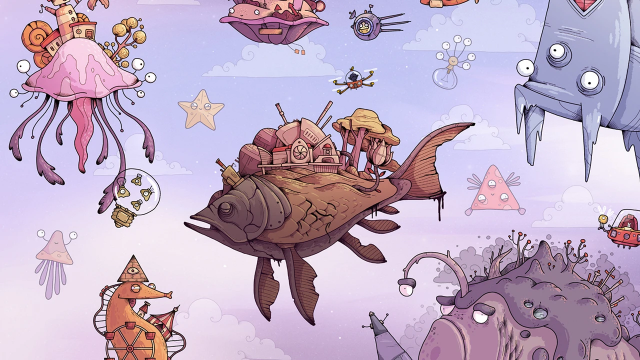Great visuals, animation, sound, and score.
A few puzzles feel unfair; unintriguing story
TOHU is an adorable point and click game with a dream-like style that reminds me of my favorite childhood picture books. With imaginative characters and world, I was excited to jump in. But without an engaging story or exceptional puzzles, the game didn’t drive me to keep playing.
TOHU takes place among various fish planets; giant fish floating in the sky each with unique creatures and characters. You play as an unnamed little girl and her robot alter-ego, Cubus. Each have their own abilities. The Girl, she is only referred to as such throughout the game, can talk to other characters, solve most puzzles, and climb up structures. Cubus on the other hand is strong and uses his strength to solve problems, such as lift heavy objects.
Though the game has this interesting mechanic, it is rarely utilized and never feels like a puzzle. The game rarely requires you to shift between the two. And when it does, either character will shake their head when they are incapable of preforming a certain action. For the most part, I played as The Girl and forgot about Cubus.
What kickstarts the story is the is the disappearance of a key object that keeps The Girl’s homefish alive. The Girl travels from fish to fish, visiting friends and collecting needed objects to return her homefish to normal. Not a complex story, but it’s all the call to action needed to get TOHU started.
It’s unfortunate that the story is so minimal. The world is so whimsical and adds a dreamlike quality to its steampunk inspired visuals. Each fish you visit has detailed sets that vary from fish to fish. A highlight was the musical score by Christopher Larkin, the composer for Hollow Knight’s score. He does a great job manufacturing the atmosphere and making it even more pleasant to be in. To match with the storybook-like quality of TOHU, a narrator weaves in and out of the game to explain the broader plot points. The Girl can talk to characters, but dialogue is brief and usually is related to solving puzzles rather than advancing the story.
TOHU has a variety of puzzles. There are the typical puzzles found in point and click games, picking up objects and using them to interact with the environment, as well as pure logic puzzles. Overall, the puzzles are fair. There are a few that are so easy, I wouldn’t call them puzzles. Though don’t expect this to be a kid’s game due to the cute visuals — some puzzles can be a bit challenging. You may have to pull out a pen and paper to try to solve a few. And there is one that I would consider so difficult that I thought I was missing some information. It either require good luck, or a lot of patience, note taking, and the ability to think many steps ahead.
Luckily, most puzzles can be assisted with the clever hint system employed by the game. I enjoyed the hint system. First off, the hints aren’t just handed to you. Instead, you complete a minigame that tests your timing skills. Secondly, once you unlock the hints, they don’t spell it out for you like a walkthrough. Rather, the game provides a series of sketches that show scenes of the answer or clues to items needed. Usually, the solution becomes obvious, but sometimes a little extra thinking is required.
Since TOHU is essentially a point and click game, on Switch the left stick becomes the cursor. In all other aspects, game plays just fine on Switch. However, there are times when it can be frustrating to use the left stick to precisely click where you want. There is also one puzzle that requires quick clicking which would have definitely been easier using a mouse. It is at times like this that the time-consuming nature of the game is more obvious.
In the age of games with quick reload screen, it has become expected that failure to complete a task, be it platforming, fighting a boss, or solving a puzzle, is greeted with a quick reload to try again. Otherwise, the player’s time is wasted and disregarded. This is especially important in games with challenging tasks or puzzles. If a player fails to complete a puzzle, they don’t want to see the same “this isn’t the solution” animation over and over. They also don’t want to click back and forth to make a character slowly walk across the screen to retry the puzzle over and over. Too much time wasted traveling around the screen rather than trying to solve the puzzle.
Though the game is pleasing visually and acoustically, it just wasn’t that compelling. There wasn’t anything outstanding about TOHU one way or the other. It is a decent point and click game, but without a driving story, I didn’t feel motivated to keep playing.
Nintendojo was provided a copy of this game for review by a third party, though that does not affect our recommendation. For every review, Nintendojo uses a standard criteria.




 ShareThis
ShareThis






